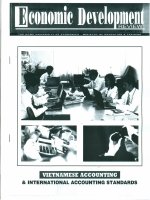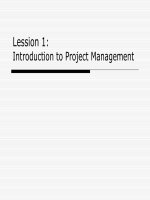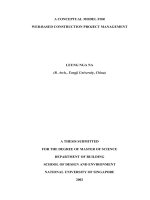Project management (1)
Bạn đang xem bản rút gọn của tài liệu. Xem và tải ngay bản đầy đủ của tài liệu tại đây (14.96 MB, 586 trang )
Food Process
Engineering
Operations
Contemporary Food Engineering
Series Editor
Professor Da-Wen Sun, Director
Food Refrigeration & Computerized Food Technology
National University of Ireland, Dublin
(University College Dublin)
Dublin, Ireland
/>
Emerging Technologies for Food Quality and Food Safety Evaluation,
edited by Yong-Jin Cho and Sukwon Kang (2011)
Food Process Engineering Operations, edited by George D. Saravacos and
Zacharias B. Maroulis (2011)
Biosensors in Food Processing, Safety, and Quality Control, edited by
Mehmet Mutlu (2011)
Physicochemical Aspects of Food Engineering and Processing, edited by
Sakamon Devahastin (2010)
Infrared Heating for Food and Agricultural Processing, edited by Zhongli Pan
and Griffiths Gregory Atungulu (2010)
Mathematical Modeling of Food Processing, edited by Mohammed M. Farid (2009)
Engineering Aspects of Milk and Dairy Products, edited by Jane Sélia dos Reis Coimbra
and José A. Teixeira (2009)
Innovation in Food Engineering: New Techniques and Products, edited by
Maria Laura Passos and Claudio P. Ribeiro (2009)
Processing Effects on Safety and Quality of Foods, edited by Enrique Ortega-Rivas (2009)
Engineering Aspects of Thermal Food Processing, edited by Ricardo Simpson (2009)
Ultraviolet Light in Food Technology: Principles and Applications, Tatiana N. Koutchma,
Larry J. Forney, and Carmen I. Moraru (2009)
Advances in Deep-Fat Frying of Foods, edited by Serpil Sahin and Servet Gülüm Sumnu (2009)
Extracting Bioactive Compounds for Food Products: Theory and Applications, edited by
M. Angela A. Meireles (2009)
Advances in Food Dehydration, edited by Cristina Ratti (2009)
Optimization in Food Engineering, edited by Ferruh Erdoˇgdu (2009)
Optical Monitoring of Fresh and Processed Agricultural Crops, edited by Manuela Zude (2009)
Food Engineering Aspects of Baking Sweet Goods, edited by Servet Gülüm Sumnu
and Serpil Sahin (2008)
Computational Fluid Dynamics in Food Processing, edited by Da-Wen Sun (2007)
Food Process
Engineering
Operations
George D. Saravacos
Zacharias B. Maroulis
Boca Raton London New York
CRC Press is an imprint of the
Taylor & Francis Group, an informa business
CRC Press
Taylor & Francis Group
6000 Broken Sound Parkway NW, Suite 300
Boca Raton, FL 33487-2742
© 2011 by Taylor & Francis Group, LLC
CRC Press is an imprint of Taylor & Francis Group, an Informa business
No claim to original U.S. Government works
Version Date: 2011908
International Standard Book Number-13: 978-1-4200-8354-5 (eBook - PDF)
This book contains information obtained from authentic and highly regarded sources. Reasonable efforts
have been made to publish reliable data and information, but the author and publisher cannot assume
responsibility for the validity of all materials or the consequences of their use. The authors and publishers
have attempted to trace the copyright holders of all material reproduced in this publication and apologize to
copyright holders if permission to publish in this form has not been obtained. If any copyright material has
not been acknowledged please write and let us know so we may rectify in any future reprint.
Except as permitted under U.S. Copyright Law, no part of this book may be reprinted, reproduced, transmitted, or utilized in any form by any electronic, mechanical, or other means, now known or hereafter invented,
including photocopying, microfilming, and recording, or in any information storage or retrieval system,
without written permission from the publishers.
For permission to photocopy or use material electronically from this work, please access www.copyright.
com ( or contact the Copyright Clearance Center, Inc. (CCC), 222 Rosewood
Drive, Danvers, MA 01923, 978-750-8400. CCC is a not-for-profit organization that provides licenses and
registration for a variety of users. For organizations that have been granted a photocopy license by the CCC,
a separate system of payment has been arranged.
Trademark Notice: Product or corporate names may be trademarks or registered trademarks, and are used
only for identification and explanation without intent to infringe.
Visit the Taylor & Francis Web site at
and the CRC Press Web site at
To
Katie Saravacos
Sincerely yours,
George Emer
Professor George D. Saravacos
Contents
Series Preface...........................................................................................................xxi
Series Editor.......................................................................................................... xxiii
Preface....................................................................................................................xxv
Authors..................................................................................................................xxvii
Chapter 1 Introduction........................................................................................... 1
1.1
1.2
1.3
Introduction................................................................................ 1
Process Diagrams.......................................................................2
Material and Energy Balances................................................... 2
1.3.1 Material Balances.......................................................... 3
1.3.2 Energy Balances............................................................ 5
1.4 Engineering Units.......................................................................6
1.5 Engineering Calculations........................................................... 7
1.5.1 Engineering Symbols....................................................7
1.5.2 Dimensions and Dimensionless Numbers.....................8
1.5.3 Notation of Numbers..................................................... 8
1.5.4 Engineering Calculations..............................................9
Application Examples...........................................................................9
Material Balance....................................................................... 14
Energy Balances....................................................................... 14
Total Energy Requirements...................................................... 16
Actual Energy Requirements.................................................... 16
Problems.............................................................................................. 16
List of Symbols................................................................................... 17
References........................................................................................... 18
Chapter 2 Transport Phenomena.......................................................................... 19
2.1
2.2
2.3
Introduction.............................................................................. 19
Steady-State Transport.............................................................20
2.2.1 Transport Rate Equations............................................20
2.2.1.1 Heat Transport.............................................20
2.2.1.2 Mass Transport............................................ 21
2.2.1.3 Momentum Transport.................................. 21
Unsteady-State Transport......................................................... 22
2.3.1 Mathematical Modeling.............................................. 22
2.3.1.1 Analytical Solution...................................... 22
2.3.1.2 Generalized Chart Solution.........................25
2.3.1.3 Numerical/Computer Solution.....................28
vii
viii
Contents
2.4
Interface Transfer.....................................................................28
2.4.1 Transfer Coefficients...................................................28
2.4.2 Dimensionless Numbers.............................................. 29
2.4.2.1 Momentum Transport (Re, Fr, f )................. 29
2.4.2.2 Heat Transfer (Bi, Fo, Gr, Gz, Le,
Nu, Pe, Pr, St)............................................... 29
2.4.2.3 Mass Transfer (Bi, Fi, Le, Pe, Sc, Sh).......... 30
Application Examples......................................................................... 30
Problems..............................................................................................34
List of Symbols...................................................................................34
References........................................................................................... 36
Chapter 3 Thermodynamics and Kinetics........................................................... 37
3.1
3.2
Introduction.............................................................................. 37
Principles of Thermodynamics................................................ 37
3.2.1 Definitions................................................................... 37
3.2.2 First Law..................................................................... 38
3.2.3 Second Law................................................................. 39
3.2.4 Calculation of Entropy Change...................................40
3.2.5 Thermodynamic Flow Processes................................40
3.2.5.1 Compression Processes................................ 41
3.2.5.2 Expansion Processes.................................... 41
3.2.5.3 Steam Power Cycle...................................... 42
3.2.5.4 Carnot Cycle................................................44
3.2.5.5 Refrigeration and Heat Pumps.....................44
3.2.6 Gas Compression......................................................... 45
3.3 Phase Equilibria.......................................................................46
3.3.1 Vapor–Liquid Equilibria............................................. 47
3.3.2 Vapor–Solid Equilibria............................................... 47
3.3.3 Water Phase Equilibria................................................ 49
3.4 Food Kinetics........................................................................... 50
3.4.1 Chemical Reactions..................................................... 50
3.4.2 Microbial Kinetics....................................................... 54
3.4.2.1 Microbial Growth........................................ 54
3.4.2.2 Microbial Inactivation................................. 55
Application Examples......................................................................... 55
Problems.............................................................................................. 58
List of Symbols................................................................................... 58
References........................................................................................... 59
Chapter 4 Overview of Food Process Technology............................................... 61
4.1
4.2
Introduction.............................................................................. 61
Food Preservation..................................................................... 62
4.2.1 Minimal Processing and Hurdle Technology.............. 62
4.2.2 Refrigeration................................................................ 62
ix
Contents
4.2.3 Freezing....................................................................... 63
4.2.4 Thermal Processing..................................................... 65
4.2.5 Concentration and Dehydration..................................66
4.2.6 Novel Food Processes.................................................. 69
4.3 Food Manufacturing................................................................. 70
4.4 Food Ingredients....................................................................... 74
4.5 Food Product Engineering........................................................ 77
Problems.............................................................................................. 77
References........................................................................................... 78
Chapter 5 Engineering Properties of Foods......................................................... 79
5.1
5.2
Introduction.............................................................................. 79
Physical Properties................................................................... 79
5.2.1 Density and Porosity................................................... 79
5.2.2 Thermal Properties...................................................... 83
5.2.2.1 Nonfrozen Foods......................................... 83
5.2.2.2 Frozen Foods...............................................84
5.2.3 Mechanical Properties................................................. 85
5.2.3.1 Static Tests................................................... 85
5.2.3.2 Dynamic Tests............................................. 86
5.2.3.3 Empirical Tests............................................ 87
5.2.4 Electrical Properties.................................................... 87
5.2.5 Acoustic Properties..................................................... 88
5.2.5.1 Sound Propagation....................................... 88
5.2.5.2 Food Applications........................................ 88
5.2.5.3 Doppler Velocimetry................................... 89
5.2.6 Colorimetric Properties............................................... 89
5.2.7 Surface Properties.......................................................90
5.2.7.1 Introduction.................................................90
5.2.7.2 The Gibbs Equation.....................................90
5.2.7.3 Liquids......................................................... 91
5.2.7.4 Solids........................................................... 91
5.3 Transport Properties.................................................................92
5.3.1 Transport Properties of Gases and Liquids.................92
5.3.2 Rheological Properties................................................ 95
5.3.3 Thermal Transport Properties..................................... 98
5.3.4 Mass Transport Properties..........................................99
5.3.4.1 Mass Diffusivity..........................................99
5.3.4.2 Permeability............................................... 101
Application Examples....................................................................... 102
Problems............................................................................................ 107
List of Symbols................................................................................. 108
References......................................................................................... 110
x
Contents
Chapter 6 Fluid Flow Operations....................................................................... 111
6.1
6.2
Introduction............................................................................ 111
Food Rheology....................................................................... 111
6.2.1 Capillary Tube Viscometry....................................... 111
6.2.2 Rotational Viscometry.............................................. 112
6.2.3 Velocity Distribution................................................. 113
6.2.4 Reynolds Number...................................................... 115
6.3 Mechanical Energy Balances................................................. 116
6.3.1 Mechanical Flow Systems......................................... 116
6.3.2 Friction in Piping Systems........................................ 119
6.3.3 Friction in Non-Newtonian Fluids............................ 121
6.3.4 Rabinowitsch–Mooney Equation.............................. 121
6.4 Piping Systems....................................................................... 122
6.4.1 Pipes and Tubes......................................................... 122
6.4.2 Pipe Fittings.............................................................. 126
6.5 Film and Oren Channel Flows............................................... 126
6.5.1 Film Flow.................................................................. 126
6.5.2 Open Channel Flow................................................... 127
6.6 Flow Measurement................................................................. 128
6.6.1 Differential Pressure Flow Meters............................ 128
6.6.1.1 U-Tube Manometer.................................... 129
6.6.1.2 Orifice Meter............................................. 130
6.6.1.3 Venturi Meter............................................. 131
6.6.1.4 Pitot Tube................................................... 131
6.6.2 Mechanical Flow Meters........................................... 133
6.6.2.1 Rotameters................................................. 133
6.6.2.2 Positive Displacement Flow Meters........... 133
6.6.3 Electrical and Magnetic Flow Meters....................... 133
6.6.3.1 Hot Wire Anemometer.............................. 133
6.6.3.2 Magnetic and Acoustic Flow Meters......... 134
6.6.4 Weir Flow Meters...................................................... 134
6.7 Pumping Equipment............................................................... 135
6.7.1 Pumps........................................................................ 135
6.7.1.1 Centrifugal Pumps..................................... 136
6.7.1.2 Positive Displacement Pumps.................... 136
6.7.1.3 Rotary Pumps............................................ 137
6.7.2 Pump Characteristics................................................ 139
6.7.2.1 Pump Curves............................................. 139
6.7.2.2 Net Positive Suction Head......................... 142
6.7.2.3 Pump Selection.......................................... 143
6.7.3 Fans and Blowers....................................................... 144
6.7.4 Vacuum Pumps.......................................................... 145
Application Examples....................................................................... 147
Problems............................................................................................ 158
List of Symbols................................................................................. 159
References......................................................................................... 160
xi
Contents
Chapter 7 Mechanical Processing Operations................................................... 161
7.1
7.2
7.3
7.4
7.5
7.6
Introduction............................................................................ 161
Particle Characteristics........................................................... 161
7.2.1 Particle Size and Shape............................................. 161
7.2.2 Particle Size Distribution.......................................... 163
7.2.3 Particle Size Analysis................................................ 164
7.2.3.1 Methods of Measurement.......................... 164
7.2.3.2 Sieve Analysis............................................ 165
Size Reduction........................................................................ 166
7.3.1 Introduction............................................................... 166
7.3.2 Cutting....................................................................... 168
7.3.2.1 Introduction............................................... 168
7.3.2.2 Cutting Tools............................................. 169
7.3.2.3 Portable Cutting Tools............................... 170
7.3.2.4 Cutting Equipment..................................... 170
7.3.3 Crushing and Grinding Operations........................... 172
7.3.3.1 Introduction............................................... 172
7.3.3.2 Crushers..................................................... 172
7.3.3.3 Grinders..................................................... 173
7.3.4 Droplet Formation..................................................... 179
7.3.4.1 Pressure Nozzles........................................ 179
7.3.4.2 Rotary Nozzles.......................................... 180
7.3.4.3 Two-Fluid Nozzles..................................... 180
Size Enlargement.................................................................... 180
7.4.1 Introduction............................................................... 180
7.4.2 Free Structuring Agglomeration............................... 181
7.4.3 Pressure Agglomeration............................................ 183
Mixing and Forming.............................................................. 184
7.5.1 Fluid Mixing............................................................. 184
7.5.1.1 Agitated Tanks........................................... 184
7.5.1.2 Industrial Mixers....................................... 187
7.5.2 Food Mixing.............................................................. 187
7.5.3 Homogenization........................................................ 188
7.5.4 Solids Mixing............................................................ 188
7.5.5 Forming Operations.................................................. 189
7.5.6 Extrusion................................................................... 190
Conveying of Solids................................................................ 191
7.6.1 Pneumatic Conveying................................................ 192
7.6.2 Hydraulic Conveying................................................. 193
7.6.3 Mechanical Conveying.............................................. 194
7.6.3.1 Belt Conveyors........................................... 194
7.6.3.2 Roll and Skate Wheel Conveyors.............. 195
7.6.3.3 Chain Conveyors........................................ 195
7.6.3.4 Bucket Elevators........................................ 196
7.6.3.5 Screw Conveyors....................................... 196
7.6.4 Hygienic Considerations............................................ 197
xii
Contents
7.7
Mechanical Separations......................................................... 197
7.7.1 Introduction............................................................... 197
7.7.2 Classification Operations.......................................... 198
7.7.2.1 Grading...................................................... 198
7.7.2.2 Sorting....................................................... 199
7.7.3 Solid/Solid Separations.............................................200
7.7.3.1 Screening...................................................200
7.7.3.2 Fluid Classification.................................... 203
7.7.4 Solid/Liquid Separations...........................................204
7.7.4.1 Screening...................................................205
7.7.4.2 Sedimentation............................................ 205
7.7.4.3 Cake Filtration...........................................205
7.7.4.4 Depth Filtration.........................................208
7.7.4.5 Sterile Filtration.........................................209
7.7.4.6 Filtration of Clear Food Liquids................209
7.7.4.7 Centrifugation............................................209
7.7.4.8 Mechanical Expression.............................. 212
7.7.5 Solid/Air Separations................................................ 216
7.7.5.1 Cyclone Separators.................................... 216
7.7.5.2 Bag Filters.................................................. 217
7.7.5.3 Air Filters................................................... 219
7.7.5.4 Electrical Filters........................................ 219
7.7.5.5 Wet Scrubbers............................................ 220
7.7.6 Removal of Food Parts.............................................. 220
7.7.6.1 Introduction............................................... 220
7.7.6.2 Removal of Undesired Food Parts............. 221
7.7.6.3 Removal of Desired Food Parts................. 221
7.7.6.4 Food Cleaning Operations......................... 221
Application Examples....................................................................... 223
Problems............................................................................................ 227
List of Symbols................................................................................. 227
References......................................................................................... 228
Chapter 8 Heat Transfer Operations.................................................................. 231
8.1
8.2
Introduction............................................................................ 231
Heat Transfer Coefficients...................................................... 231
8.2.1 Plane Walls................................................................ 232
8.2.2 Cylindrical Walls...................................................... 234
8.2.3 Natural Convection................................................... 235
8.2.4 Forced Circulation..................................................... 238
8.2.5 Falling Films............................................................. 239
8.2.6 Condensing Vapors....................................................240
8.2.7 Boiling Liquids.......................................................... 241
8.2.8 Radiation Heat Transfer............................................ 242
xiii
Contents
8.2.9 Combined Convection and Radiation.......................246
8.2.10 Heat Transfer Factor..................................................246
8.3 Heat Exchangers..................................................................... 247
8.3.1 Heat Transfer Rate.....................................................248
8.3.2 Double-Pipe Heat Exchangers................................... 249
8.3.3 Heat Transfer Coefficients......................................... 253
8.3.4 Fouling of Heat Exchangers...................................... 255
8.3.5 Shell and Tube Heat Exchangers............................... 256
8.3.5.1 Heat Transfer Surface................................ 257
8.3.5.2 Heat Exchanger Structure/Operation......... 258
8.3.6 Plate Heat Exchangers............................................... 258
8.3.7 Agitated Heat Exchangers.........................................260
8.3.7.1 Scraped-Surface Heat Exchangers............ 261
8.3.7.2 Agitated-Vessel Heat Exchangers.............. 261
8.3.7.3 Batch Heating............................................ 262
8.3.8 Fin Heat Exchangers................................................. 263
8.3.9 Direct Heat Transfer..................................................264
8.4 Electrical/Radiation Heating.................................................. 265
8.4.1 Ohmic Heating.......................................................... 265
8.4.2 Microwave and Dielectric Heating............................ 265
8.4.3 Infrared Heating........................................................ 267
8.4.4 Solar Heating............................................................. 268
Application Examples....................................................................... 269
Heat Transfer Coefficient........................................................ 271
Heat Transfer Surface............................................................. 272
Heat Transfer Coefficients...................................................... 275
Plate Heat Exchanger............................................................. 276
Problems............................................................................................ 277
List of Symbols................................................................................. 279
References.........................................................................................280
Chapter 9 Thermal Processing Operations........................................................ 281
9.1
9.2
Introduction............................................................................ 281
Thermal Preservation Processes............................................ 281
9.2.1 Introduction............................................................... 281
9.2.2 Kinetics of Thermal Inactivation.............................. 282
9.2.2.1 Inactivation of Microorganisms and
Enzymes.................................................... 282
9.2.2.2 Heat Damage to Food Components........... 285
9.2.3 Heat Transfer Considerations.................................... 287
9.2.3.1 Heat Transfer Coefficients......................... 287
9.2.3.2 Unsteady-State Heat Transfer.................... 288
9.2.4 In-Container Sterilization......................................... 291
9.2.4.1 General Method......................................... 291
9.2.4.2 Formula Method........................................ 292
xiv
Contents
9.2.4.3 Commercial Sterility................................. 294
9.2.4.4 In-Container Sterilizers............................. 294
9.2.5 Continuous-Flow Sterilization.................................. 299
9.2.5.1 Sterilization Flowsheet.............................. 299
9.2.5.2 Sterilization Equipment.............................300
9.2.5.3 Holding Tube............................................. 301
9.2.5.4 Food Suspensions......................................302
9.2.6 Pasteurization............................................................302
9.2.6.1 Continuous-Flow Pasteurization................304
9.2.6.2 Batch Pasteurization.................................. 305
9.2.7 Blanching..................................................................306
9.3 Thermal Treatment Processes................................................307
9.3.1 Baking.......................................................................308
9.3.1.1 Heat Transfer Considerations....................308
9.3.1.2 Baking Ovens............................................308
9.3.2 Roasting.....................................................................309
9.3.3 Frying........................................................................309
Application Examples....................................................................... 310
Problems............................................................................................ 316
List of Symbols................................................................................. 318
References......................................................................................... 319
Chapter 10 Evaporation Operations..................................................................... 321
10.1 Introduction............................................................................ 321
10.2 Heat Transfer.......................................................................... 321
10.2.1 Physical Properties.................................................... 321
10.2.2 Heat Transfer Coefficients......................................... 322
10.2.3 Fouling in Evaporators.............................................. 323
10.2.4 Evaporation of Fruit Juices........................................ 324
10.3 Design of Evaporators............................................................ 325
10.3.1 Material and Energy Balances.................................. 325
10.3.2 Short Residence–Time Evaporators.......................... 327
10.3.2.1 Film Evaporators....................................... 327
10.3.2.2 Long-Tube Vertical Evaporators................ 329
10.3.2.3 Plate Evaporators....................................... 330
10.3.2.4 Agitated Film Evaporators......................... 330
10.3.2.5 Centrifugal Film Evaporators.................... 331
10.3.3 Long Residence–Time Evaporators........................... 331
10.3.3.1 Jacketed Vessel Evaporators...................... 332
10.3.3.2 Short Tube Evaporators.............................. 332
10.3.3.3 Forced Circulation Evaporators................. 332
10.4 Energy-Saving Evaporation Systems...................................... 333
10.4.1 Multiple Effect Evaporators...................................... 333
10.4.2 Vapor Recompression Evaporators........................... 336
Contents
xv
10.4.3 Combined Reverse Osmosis/Evaporation................. 337
10.4.4 Water Desalination.................................................... 338
10.5 Auxiliary Equipment.............................................................. 338
10.5.1 Vapor–Liquid Separators.......................................... 338
10.5.2 Condensers................................................................ 339
10.5.3 Vacuum Systems.......................................................340
Application Examples....................................................................... 341
Problems............................................................................................ 349
List of Symbols................................................................................. 350
References......................................................................................... 350
Chapter 11 Drying Operations............................................................................. 353
11.1 Introduction............................................................................ 353
11.2 Heat and Mass Transfer.......................................................... 354
11.2.1 Heat and Mass Transfer Coefficients........................ 354
11.2.2 Heat and Mass Transfer Analogy.............................. 355
11.3 Psychrometrics....................................................................... 356
11.3.1 Water–Air Mixtures.................................................. 356
11.3.2 Psychrometric Charts................................................ 359
11.4 Drying Kinetics...................................................................... 361
11.4.1 Drying Rates............................................................. 361
11.4.2 Drying Constant........................................................ 362
11.4.3 Moisture Diffusivity.................................................. 363
11.4.4 Empirical Model........................................................364
11.5 Drying Technology................................................................. 365
11.5.1 Process Technology................................................... 365
11.6 Dryer Design.......................................................................... 367
11.6.1 Design of Industrial Dryers....................................... 367
11.6.2 Selection of Industrial Dryers................................... 367
11.6.3 Material and Energy Balances.................................. 368
11.7 Drying Equipment.................................................................. 369
11.7.1 Sun Drying................................................................ 369
11.7.2 Solar Dryers.............................................................. 370
11.7.3 Silo and Bin Dryers................................................... 371
11.7.4 Tray Dryers................................................................ 372
11.7.5 Tunnel or Truck Dryers............................................. 372
11.7.6 Belt Dryers................................................................ 372
11.7.7 Rotary Dryers............................................................ 373
11.7.8 Fluidized Bed Dryers................................................ 373
11.7.9 Spouted Bed Dryers.................................................. 374
11.7.10Pneumatic or Flash Dryers........................................ 375
11.7.11Spray Dryers.............................................................. 375
11.7.12Drum Dryers............................................................. 376
11.7.13Vacuum Dryers.......................................................... 376
xvi
Contents
11.7.14Freeze Dryers............................................................ 377
11.7.15Agitated Dryers......................................................... 378
11.7.16Microwave Dryers..................................................... 378
11.7.17Impingement Dryers.................................................. 379
11.7.18Special Dryers........................................................... 379
11.7.18.1Centrifugal Dryers..................................... 379
11.7.18.2Explosion-Puff Drying.............................. 380
11.7.18.3Foam-Mat Drying...................................... 380
11.7.18.4Acoustic Dryers......................................... 380
11.8 Energy Efficiency in Drying.................................................. 380
11.8.1 Heat Sources for Drying............................................ 381
11.8.2 Heat Recovery........................................................... 381
Application Examples....................................................................... 382
Problems............................................................................................ 391
List of Symbols................................................................................. 393
References......................................................................................... 394
Chapter 12 Refrigeration and Freezing Operations............................................. 395
12.1 Introduction............................................................................ 395
12.2 Cold Generation...................................................................... 395
12.2.1 Mechanical Compression.......................................... 395
12.2.1.1 Refrigeration Cycles.................................. 396
12.2.1.2 Coefficient of Performance........................ 398
12.2.1.3 Shortcut Modeling.....................................400
12.2.1.4 Refrigerants...............................................400
12.2.1.5 Compressors.............................................. 401
12.2.1.6 Evaporators and Condensers......................403
12.2.1.7 Capacity Control........................................405
12.2.2 Cryogenic Liquids.....................................................406
12.2.3 Ice Cooling................................................................406
12.2.4 Vacuum Cooling........................................................407
12.3 Cooling of Foods....................................................................408
12.3.1 Cooling Load.............................................................408
12.3.2 Cooling Equipment...................................................409
12.3.2.1 Liquid Foods..............................................409
12.3.2.2 Solid Foods................................................409
12.4 Food Freezing......................................................................... 410
12.4.1 Freezing Time........................................................... 410
12.4.2 Heat Load.................................................................. 412
12.4.3 Freezing Equipment.................................................. 412
12.4.3.1 Air Freezing Equipment............................ 412
12.4.3.2 Cold Surface Freezers................................ 415
12.4.3.3 Heat Exchanger Freezers........................... 415
12.4.3.4 Frozen Pellets............................................. 415
12.4.3.5 Cryogenic Liquids...................................... 416
Contents
xvii
12.4.4 Thawing of Frozen Foods......................................... 416
12.4.4.1 Convective Thawing.................................. 416
12.4.4.2 Vacuum Thawing....................................... 417
12.4.4.3 Contact Thawing........................................ 417
12.4.4.4 Electrical Thawing.................................... 417
12.5 Cold Storage of Foods............................................................ 418
12.5.1 Cold Storage Rooms.................................................. 418
12.5.2 Cold Storage Conditions............................................ 419
12.5.3 CA Storage................................................................ 420
Application Examples....................................................................... 421
Technical Data........................................................................ 424
Application to Apple Storage................................................. 426
Process Data.............................................................. 426
Calculations............................................................................ 427
Apples in Storage Room........................................... 427
Physical Properties of Green Peas.......................................... 429
Ice Properties.......................................................................... 429
Refrigeration Specifications................................................... 429
Fluidized Bed Specifications.................................................. 429
Fluidized Bed Operation......................................................... 430
Calculated Results.................................................................. 430
Problems............................................................................................ 432
List of Symbols................................................................................. 433
References......................................................................................... 434
Chapter 13 Mass Transfer Operations................................................................. 435
13.1 Introduction............................................................................ 435
13.2 Distillation.............................................................................. 436
13.2.1 Vapor/Liquid Equilibria............................................ 436
13.2.1.1 Activity Coefficients and Relative
Volatility.................................................. 437
13.2.1.2 Nonideal Mixtures and Azeotropes........... 438
13.2.1.3 Volatile Food Aromas................................440
13.2.2 Simple Distillations................................................... 441
13.2.2.1 Differential Distillation............................. 441
13.2.2.2 Steam Distillation...................................... 442
13.2.3 Fractional Distillation............................................... 443
13.2.3.1 Distillation Columns.................................. 443
13.2.3.2 Equilibrium Stages....................................444
13.2.3.3 Column Efficiency.....................................448
13.2.4 Food Distillations......................................................449
13.2.4.1 Ethanol Distillation....................................449
13.2.4.2 Aroma Recovery........................................ 451
13.2.4.3 Spinning Cone Stripping Column............. 452
13.2.5 Molecular Distillation............................................... 453
xviii
Contents
13.3 Solvent Extraction.................................................................. 453
13.3.1 Liquid/Liquid and Liquid/Solid Equilibria............... 453
13.3.2 Equilibrium Stages.................................................... 455
13.3.3 Mass Transfer Considerations................................... 457
13.3.4 Solvent Extraction Equipment................................... 458
13.4 Gas/Liquid Absorption........................................................... 459
13.4.1 Gas/Liquid Equilibria...............................................460
13.4.2 Absorption Operations..............................................460
13.4.2.1 Agitated Vessels.........................................460
13.4.2.2 Tray Columns............................................ 461
13.4.2.3 Packed Towers........................................... 461
13.4.2.4 Gas Scrubbers............................................ 463
13.5 Adsorption and Ion Exchange................................................464
13.5.1 Adsorption Equilibria and Mass Transfer.................464
13.5.2 Adsorption Equipment..............................................465
13.5.3 Ion Exchange Equipment..........................................466
13.5.4 Food Applications of Adsorption.............................. 467
13.5.4.1 Water Treatment........................................ 467
13.5.4.2 Recovery of Valuable Components............ 467
13.5.4.3 Removal of Undesirable Components.......468
13.6 Crystallization from Solution.................................................468
13.6.1 Solubility in Crystallization......................................469
13.6.2 Nucleation and Mass Transfer...................................469
13.6.3 Commercial Crystallizers......................................... 470
13.7 Food Packaging...................................................................... 471
Application Examples....................................................................... 472
Problems............................................................................................480
List of Symbols................................................................................. 481
References......................................................................................... 482
Chapter 14 Novel Food Process Operations........................................................ 485
14.1 Introduction............................................................................ 485
14.2 Membrane Separation Operations.......................................... 485
14.2.1 Introduction............................................................... 485
14.2.2 Mass Transfer Aspects.............................................. 486
14.2.3 Membrane Modules................................................... 488
14.2.4 Membrane Separation Systems................................. 489
14.2.4.1 Pressure-Driven Separations..................... 489
14.2.4.2 Special Membrane Separations................. 490
14.2.5 Microfiltration and Ultrafiltration............................. 492
14.2.5.1 Microfiltration............................................ 492
14.2.5.2 Ultrafiltration............................................. 493
14.2.6 Reverse Osmosis and Nanofiltration......................... 495
14.2.6.1 RO Systems................................................ 495
14.2.6.2 Food Applications of RO........................... 495
Contents
xix
14.3 Supercritical Fluid Extraction................................................ 496
14.3.1 Supercritical Fluids................................................... 496
14.3.2 SCF Extraction Operations....................................... 497
14.3.3 Food Applications of SCF Extraction....................... 498
14.4 Freeze Concentration.............................................................. 499
14.4.1 Crystallization of Ice................................................. 499
14.4.2 Ice Separation............................................................500
14.4.3 Food Applications.....................................................500
14.5 Nonthermal Food Preservation.............................................. 501
14.5.1 Food Irradiation........................................................ 501
14.5.1.1 Radiation Dosages..................................... 501
14.5.1.2 Food Irradiation Equipment...................... 502
14.5.2 High-Pressure Processing......................................... 503
14.5.3 Pulsed Electric Field Processing...............................504
Application Examples.......................................................................504
Problems............................................................................................507
List of Symbols................................................................................. 508
References.........................................................................................509
Chapter 15 Elements of Food Packaging Operations.......................................... 511
15.1 Introduction............................................................................ 511
15.2 Packaging Materials............................................................... 511
15.2.1 Metals........................................................................ 511
15.2.2 Glass.......................................................................... 513
15.2.3 Paper and Cardboard................................................. 513
15.2.4 Plastics....................................................................... 514
15.3 Preparation of Food Containers............................................. 516
15.3.1 Forming of Packages................................................. 516
15.3.1.1 Metal Containers....................................... 516
15.3.1.2 Cartons and Cardboard Packages.............. 516
15.3.1.3 Film-Based Packages................................. 516
15.3.2 Filling of Packages.................................................... 517
15.3.3 Closing of Packages.................................................. 519
15.3.4 Processing of Packages............................................. 519
15.3.4.1 Conventional Thermal Processing............. 519
15.3.4.2 Aseptic Packaging..................................... 520
15.4 Handling of Food Packages.................................................... 521
References......................................................................................... 521
Chapter 16 Spreadsheet Applications.................................................................. 523
16.1 Introduction............................................................................ 523
16.2 Shell and Tubes Heat Exchanger............................................ 524
16.2.1 Problem Formulation................................................. 524
16.2.2 Problem Solution....................................................... 524
16.2.3 Excel Implementation................................................ 527
xx
Contents
16.3 Psychrometric Calculations.................................................... 528
16.3.1 Problem Formulation................................................. 528
16.3.2 Problem Solution....................................................... 529
16.3.3 Excel Implementation................................................ 529
16.4 Psychrometric Chart............................................................... 531
16.4.1 Problem Formulation................................................. 532
16.4.2 Problem Solution....................................................... 532
16.4.3 Excel Implementation................................................ 532
16.5 Calculations on Psychrometric Chart..................................... 533
16.5.1 Problem Formulation................................................. 533
16.5.2 Problem Solution....................................................... 535
16.5.3 Excel Implementation................................................ 535
16.6 Isotherms................................................................................ 535
16.6.1 Problem Formulation................................................. 536
16.6.2 Excel Implementation................................................ 537
16.7 Fitting Rheological Data for Chocolate.................................. 539
16.7.1 Problem Formulation.................................................540
16.7.2 Excel Implementation................................................ 541
References......................................................................................... 542
Appendix A............................................................................................................ 543
Series Preface
Contemporary Food Engineering
Food engineering is the multidisciplinary field of applied physical sciences combined
with the knowledge of product properties. Food engineers provide the technological
knowledge transfer essential to the cost-effective production and commercialization
of food products and services. In particular, food engineers develop and design processes and equipment in order to convert raw agricultural materials and ingredients into safe, convenient, and nutritious consumer food products. However, food
engineering topics are continuously undergoing changes to meet diverse consumer
demands, and the subject is being rapidly developed to reflect market needs.
In the development of food engineering, one of the many challenges is to employ
modern tools and knowledge, such as computational materials science and nanotechnology, to develop new products and processes. Simultaneously, improving food
quality, safety, and security continue to be critical issues in food engineering study.
New packaging materials and techniques are being developed to provide more protection to foods, and novel preservation technologies are emerging to enhance food
security and defense. Additionally, process control and automation regularly appear
among the top priorities identified in food engineering. Advanced monitoring and
control systems are developed to facilitate automation and flexible food manufacturing. Furthermore, energy saving and minimization of environmental problems
continue to be important food engineering issues, and significant progress is being
made in waste management, the efficient utilization of energy, and the reduction of
effluents and emissions in food production.
The Contemporary Food Engineering Series, consisting of edited books, attempts
to address some of the recent developments in food engineering. Advances in classical unit operations in engineering applied to food manufacturing are covered as well
as such topics as progress in the transport and storage of liquid and solid foods; heating, chilling, and freezing of foods; mass transfer in foods; chemical and biochemical aspects of food engineering and the use of kinetic analysis; dehydration, thermal
processing, nonthermal processing, extrusion, liquid food concentration, membrane
processes, and applications of membranes in food processing; shelf life, electronic
indicators in inventory management; sustainable technologies in food processing;
and packaging, cleaning, and sanitation. The books are aimed at professional food
scientists, academics researching food engineering problems, and graduate-level
students.
The books’ editors are leading engineers and scientists from many parts of the
world. All the editors were asked to present their books to address the market’s need
and pinpoint the cutting-edge technologies in food engineering.
All contributions are written by internationally renowned experts who have both
academic and professional credentials. All authors have attempted to provide critical,
xxi
xxii
Series Preface
comprehensive, and readily accessible information on the art and science of a relevant topic in each chapter, with reference lists for further information. Therefore,
each book can serve as an essential reference source to students and researchers in
universities and research institutions.
Da-Wen Sun
Series Editor
Series Editor
Professor Da-Wen Sun, PhD, was born in
Southern China and is a world authority on food
engineering research and education. His main
research activities include cooling, drying, and
refrigeration processes and systems; quality and
safety of food products; bioprocess simulation and
optimization; and computer vision technology. His
innovative studies on vacuum cooling of cooked
meats, pizza quality inspection by computer vision,
and edible films for shelf-life extension of fruits
and vegetables have been widely reported in the
national and international media.
Dr. Sun received first-class BSc honors and an MSc in mechanical engineering,
and a PhD in chemical engineering in China before working at various universities
in Europe. He became the first Chinese national to be permanently employed in an
Irish university when he was appointed college lecturer at the National University
of Ireland, Dublin (University College Dublin) in 1995, and was then continuously
promoted in the shortest possible time to senior lecturer, associate professor, and full
professor. Dr. Sun is now professor of food and biosystems engineering and director
of the Food Refrigeration and Computerized Food Technology Research Group at
the University College Dublin.
As a leading educator in food engineering, Dr. Sun has contributed significantly
to the field of food engineering. He has trained many PhD students who have made
their own contributions to the industry and academia. He has also, on a regular
basis, given lectures on the advances in food engineering at academic institutions
internationally and delivered keynote speeches at international conferences. As a
recognized authority in food engineering, Dr. Sun has been conferred adjunct/visiting/consulting professorships from 10 top universities in China including Zhejiang
University, Shanghai Jiaotong University, Harbin Institute of Technology, China
Agricultural University, South China University of Technology, and Jiangnan
University. In recognition of his significant contribution to food engineering worldwide and for his outstanding leadership in the field, the International Commission
of Agricultural and Biosystems Engineering (CIGR) awarded him the CIGR Merit
Award in 2000 and again in 2006; the Institution of Mechanical Engineers based in
the United Kingdom named him Food Engineer of the Year 2004; in 2008 he was
awarded the CIGR Recognition Award in recognition of his distinguished achievements as the top 1% of agricultural engineering scientists around the world; in 2007,
Dr. Sun was presented with the AFST(I) Fellow Award by the Association of Food
Scientists and Technologists (India); and in 2010, he was presented with the CIGR
Fellow Award; the title of “Fellow” is the highest honor in CIGR, and is conferred to
individuals who have made sustained, outstanding contributions worldwide.
xxiii
xxiv
Series Editor
Dr. Sun is a fellow of the Institution of Agricultural Engineers and a fellow of
the Institution of Engineers of Ireland. He has also received numerous awards for
teaching and research excellence, including the President’s Research Fellowship, and
has received the President’s Research Award from the University College Dublin
on two occasions. He is editor-in-chief of Food and Bioprocess Technology—
An International Journal (Springer); series editor of the Contemporary Food
Engineering Series (CRC Press/Taylor & Francis); former editor of the Journal
of Food Engineering (Elsevier); and an editorial board member for the Journal of
Food Engineering (Elsevier), the Journal of Food Process Engineering (Blackwell),
Sensing and Instrumentation for Food Quality and Safety (Springer), and the Czech
Journal of Food Sciences. Dr. Sun is also a chartered engineer.
On May 28, 2010, Dr. Sun was awarded membership to the Royal Irish Academy
(RIA), which is the highest honor that can be attained by scholars and scientists
working in Ireland. At the 51st CIGR General Assembly held during the CIGR World
Congress in Quebec City, Canada, in June 2010, he was elected as incoming president of CIGR, and will become CIGR president in 2013–2014; the term of the presidency is six years, two years each for serving as incoming president, president, and
past president.









